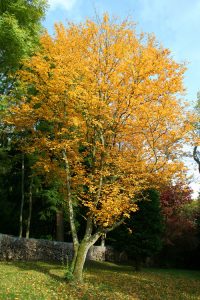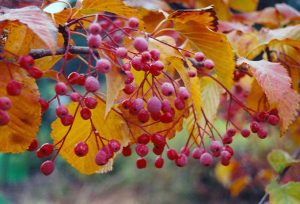Hello readers,
Have you seen the Korean Mountainash next to the Chapel? It is not as majestic as the pine but it is delicate and pretty in its own way, aesthetically pleasing throughout the year.
Spring is all about green. When I met this ornamental tree on the tree walk on May 18th, its crown was thriving in an elliptical shape with luxuriant foliage. It seemed young since it’s about 3 meters tall, far from its height potential of 12-15 meters. The dark green leaves are simple, toothed, smooth with an acute tip and a round base. White buds, growing on inflorescences, are cloaked with green sepals. Scarlet globose fruits can be seen hanging from the twigs, with dimples on sides and white little dots on the surface. These fruits are pomes, the same type as apples, but much smaller with a diameter of about 1 cm.
Come with summer are the pure white flowers. When I walked past it about 2 weeks later, it had already put on a creamy white cover-up unawares. The five-petal flowers were grouped in corymbs. The stamens looked ethereal in the middle of the flowers, which made me think of the beautiful crest on a white peacock.
Then when fall brings yellow to the world, it won’t leave the Korean Mountainash out. I haven’t seen its look in autumn but I’m sure the mix of orange-red flowers and red mature fruits will look fantastic. Can’t wait to see it in the fall term!
Which look of the Korean Mountainash is your favorite? Have you seen the Korean Mountainash elsewhere on campus?
One strange thing about the observation during the tree walk was that the red pomes were already present when the flowers were still in the form of buds. But my source says that the flowers should be followed by the fruits. I haven’t found the reason behind this during research. What do you think?
Until next time!
Olivia
Source: http://www.missouribotanicalgarden.org/PlantFinder/PlantFinderDetails.aspx?kempercode=c151








